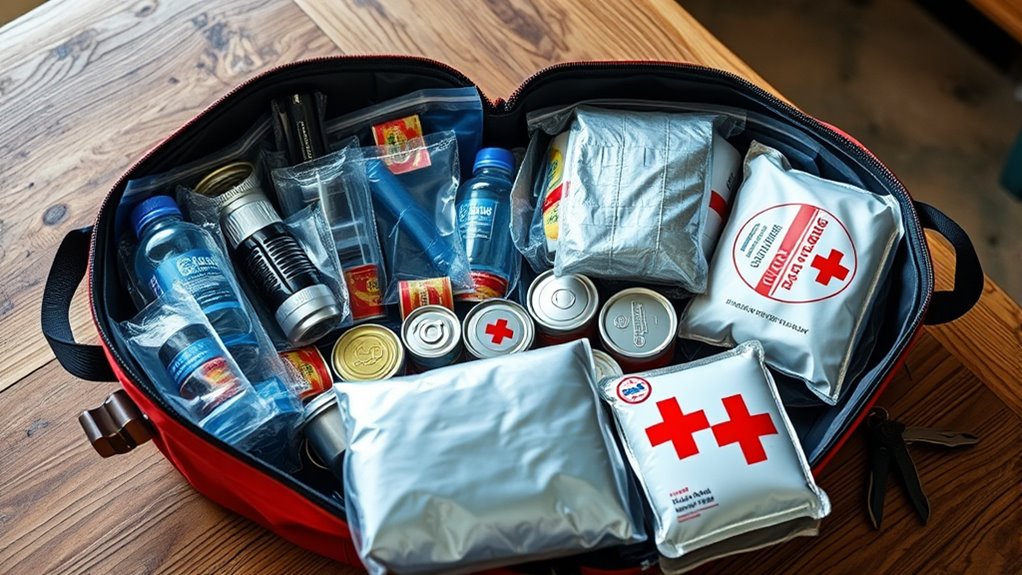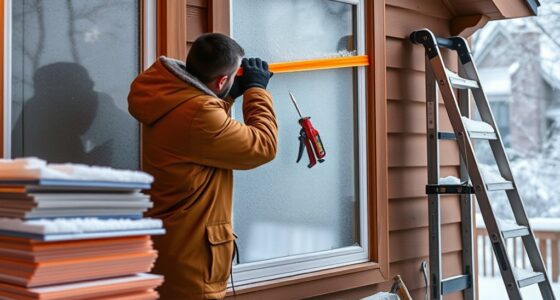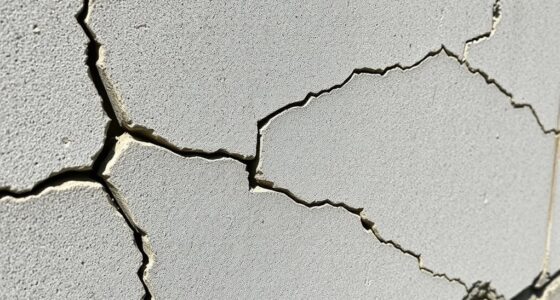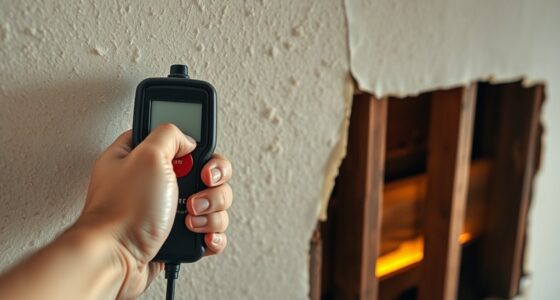To prepare an emergency kit for home disasters, pack a sturdy, waterproof container with essentials like at least one gallon of water per person for three days, non-perishable food, and a manual can opener. Include a first aid kit, medications, hygiene supplies, flashlights, batteries, and a battery-powered radio. Don’t forget clothing, blankets, and supplies for pets or infants if needed. Keep your kit accessible and updated—continue to learn more on how to customize it for your household.
Key Takeaways
- Use a durable, waterproof container that is easily accessible and organized for quick retrieval during emergencies.
- Pack at least three days’ supply of water (one gallon per person daily) and non-perishable, easy-to-prepare foods.
- Include a comprehensive first aid kit, necessary medications, hygiene items, and personal supplies for all household members.
- Equip your kit with flashlights, batteries, a radio, glow sticks, multi-tool, warm clothing, and blankets for safety and comfort.
- Add supplies tailored to household members’ needs, such as baby or pet items, and store everything in a cool, dark, accessible location.

Preparing an emergency kit for home disasters is essential to guarantee your safety and well-being when unexpected events occur. You never know when a storm, earthquake, or other crisis might strike, so having the right supplies on hand can make all the difference. Your kit should be easy to access, well-organized, and stocked with essentials to sustain you and your loved ones until help arrives or the danger subsides. Start by choosing a sturdy, waterproof container that can hold everything securely and be quickly grabbed if you need to evacuate. Remember, simplicity and accessibility are key; avoid overpacking with items you won’t need in a crisis.
Having an organized, accessible emergency kit is vital for safety during unexpected home disasters.
First, focus on water. You should have at least one gallon per person per day for a minimum of three days. Water is your top priority, as you’ll need it for drinking, sanitation, and cooking. Store bottled water in a cool, dark place, and consider adding water purification tablets or a portable filter as a backup. Next, pack non-perishable food items that require minimal preparation, like energy bars, canned goods, dried fruits, nuts, and jerky. Don’t forget a manual can opener if you’re including canned foods. This way, you’ll have enough calories to keep your energy up during stressful times.
Your emergency kit also needs basic first aid supplies. Include bandages of various sizes, antiseptic wipes, antibiotic ointment, pain relievers, allergy medication, and any necessary prescriptions. A first aid manual can be helpful if you’re unfamiliar with medical procedures. Personal hygiene items are equally important—bring moist towelettes, hand sanitizer, soap, feminine hygiene products, and a small towel. These will help you maintain cleanliness and prevent infections in unsanitary conditions.
Lighting is another critical aspect. Pack flashlights with extra batteries, a battery-powered or hand-crank radio, and glow sticks if possible. These will keep you informed and safe in the dark. Don’t forget to include a multi-tool or Swiss Army knife, which can come in handy for numerous tasks. Also, prepare a set of warm clothing, sturdy shoes, and blankets, especially if you might need to evacuate or if temperatures drop unexpectedly. Incorporating home safety measures into your preparedness can further reduce risks and protect your household during emergencies.
Lastly, consider any special needs members in your household—babies, elderly, or pets—and include their specific supplies. Medication, diapers, pet food, and comfort items can help reduce stress during an emergency. By carefully selecting and packing these essentials, you’ll be better equipped to face home disasters confidently, ensuring safety and comfort for everyone involved. Remember, regularly reviewing and updating your kit keeps it ready for any emergency that may come your way.
Frequently Asked Questions
How Often Should I Update My Emergency Kit?
You should update your emergency kit at least once a year to guarantee all supplies are fresh and functional. Check expiration dates on food, water, and medications, and replace items as needed. Additionally, review your kit after any significant event or change in your household, such as new family members or relocations. Regular updates keep your kit ready, so you’re prepared for any disaster without unnecessary delays.
Are There Specific Items for Pets in the Kit?
Yes, include pet-specific items like food, water, and medications to keep your furry friend safe. You might worry about space, but imagine your pet’s comfort and health during an emergency. Pack a leash, collar, and essential supplies in a waterproof container. Don’t forget a familiar blanket or toy to help ease their anxiety. Preparing these items guarantees your pet stays protected and calm in stressful situations.
What Should I Include for Infants or Elderly Family Members?
You should include special items like formula, baby food, bottles, and diapers for infants, along with wipes and a change of clothes. For elderly family members, pack necessary medications, hearing aids, glasses, and mobility aids if needed. Also, add in comfort items, medical supplies, and any specific needs they have. make certain you have enough supplies to keep them comfortable and safe during an emergency.
How Do I Store My Emergency Kit Safely?
You should store your emergency kit in a secure, easily accessible location, like a closet or basement, but keep it out of reach of children and pets. Use sturdy containers to safeguard your supplies from moisture and pests. Label everything clearly, and rotate items regularly to guarantee freshness. By balancing safety and accessibility, you prepare your family effectively without risking accidental harm or delays during emergencies.
Should I Customize My Kit for Different Types of Disasters?
Yes, you should customize your kit for different types of disasters. Identify the most likely emergencies in your area, like hurricanes or earthquakes, and include specific items such as water purification tablets or dust masks. Regularly review and update your kit to address changing risks. Tailoring your supplies guarantees you’re better prepared for various scenarios, giving you peace of mind and increased safety during emergencies.
Conclusion
Now, imagine yourself in a dark, quiet house, the storm raging outside. Your emergency kit sits ready, a beacon of hope amidst chaos. With flashlights flickering and bottled water nearby, you feel prepared and secure. Having packed essentials like first aid supplies, snacks, and important documents, you’re ready to face anything. Keep your kit accessible and up-to-date, so when disaster strikes, you’re not just reacting—you’re confidently weathering the storm.








